Section 15
Line-Numbered and Line-Lettered Text
15.1 Fundamentals
15.2 Margin-Numbered Paragraphs
15.3 General Provisions for Line-Numbered Text
15.4 Line-Numbered Prose
15.5 Line-Numbered Poetry
15.6 Interspersed Line-Numbered Prose and Verse
15.7 Poetic Rhyme Scheme
15.8 Counted Words
15.9 Verse-Numbered Texts in Religious Material
15.10 Samples
a. Follow print for blocked or indented paragraphs.
b. Insert the paragraph number before the beginning of the paragraph.
c. Number every paragraph, even if only some paragraphs are numbered in print.
(See Sample 15-1: Margin-Numbered Paragraphs on page 15-8.)
a. Line-numbered text may not appear on any line with a print or braille page number.
b. Place the line number, with the numeric indicator, at the right margin of the braille line on which the print line begins.
c. All line-numbered text ends so that at least two blank cells separate the text and the longest line number on the braille page.
d. Do not repeat the line number when a print line is longer than one braille line.
e. Follow print when a word is divided at the end of a line.
f. Resume using the full width of the line after the completion of the line-numbered text.
g. A transcriber's note can extend to the right margin when placed before the beginning of, or following the end of, the line-numbered text.
a. Follow print for indented or blocked paragraphing.
b. Every print line of prose is numbered in braille, even when the lines are not numbered in print.
c. Three blank cells precede a new print line when it begins in the middle of a braille line. Do not insert three blank cells before a new print line when it begins a new braille line. (See Sample 15-2: Prose Numbered Every Ten Lines on page 15-9.)
d. On the Transcriber's Notes page, inform the reader about the function of the three blank cells when line-numbered prose occurs in more than one section in a volume. Insert a transcriber's note before the text when the three blank cells is used in only one section. Sample:
Three blank cells occurring within a braille line indicate the beginning of a new print line.
(See Sample 15-3: Line-Numbered Prose with Transcriber's Note on page 15-10.)
e. Two individually numbered print lines cannot start on the same braille line, as only one line number can be at the margin. (See Sample 15-4: Short Numbered Lines on page 15-11.)
a. Use poetry format. (See Formats, §13, Poetry and Song Lyrics.)
b. Follow print for line numbers. Do not add numbers that do not occur in print.
c. Maintain the two-cell margin before print line numbers whether these numbers are implied or actually shown.
(See Sample 15-5: Poetry Line Numbers on page 15-12.)a. Use format outlined above in Formats, §15.5.1 a–c.
b. Insert three blank spaces in braille when in print a significant blank space is left between the speaker's name and the first word of the dialogue. A transcriber's note is required explaining this format.
(See Sample 15-6: Lines of Dialogue on page 15-13.)
a. Prose. Every print line is numbered.
b. Verse. Use only the line numbers shown in print.
(See Sample 15-7: Mixed Prose and Poetry on page 15-14.)
Example 15-1: Poetic Rhyme Scheme within Body of Text

,! rhyme s*eme 9 ^! l9es ( ,y1ts
.1,resurrec;n is abba4 ,i saw a />+
virg9 /& .2a _/ ,": holy ,dionysus
di$1 .2;b _/ ,& te> ! he>t \ ( 8
side1 .2;b _/ ,& lay ! he>t ^u h] h& .2a
a. Use poetry format. (See Formats, §13, Poetry and Song Lyrics.)
b. Line-lettered text cannot appear on any line with a print or braille page number.
c. Use line number format (see Formats, §15.5) when rhyme scheme letters are printed in either the left or right margin.
d. Place each letter, preceded by the grade 1 indicator as required, at the right margin of the braille line on which the lettered line begins.
e. Omit font attributes.
f. Do not repeat the letter when a print line requires more than one braille line.
g. End all lines in this format so that at least two blank cells are left before the rhyme scheme letters.
Example 15-2: Rhyme Scheme in Right Margin

,he is t fall5 l.e t lies z hurl$1 a
,t lies unlift$ n[1 come dew1 come ;b
⠀⠀ru/1
,b / lies po9t$ z x pl[$ ! du/4 ;b
,if we :o si<t al;g x r.d ! _w a
,see no?+ wor?y to h be5 xs m>k1 ;c
a. Use poetry format. (See Formats, §13, Poetry and Song Lyrics.)
b. Follow print for line numbers. Do not add numbers that do not occur in print.
c. Place line numbers, preceded by the numeric indicator, at the right margin.
d. Position the letters of the rhyme scheme so that they end one cell before the longest line number on the braille page.
(See Sample 15-8: Poem with Line Numbers and Rhyme Scheme on page 15-16.)
a. Treat counted words as line-numbered text, leaving three spaces at the end of each line of text.
b. Insert a transcriber's note explaining the use of the three blank cells, and that the number refers to the end of the print line. Sample:
Three blank cells indicate the end of a print line. The numbers in the right margin are the number of words read at the point of the three blank cells.
c. Insert a blank line between the transcriber's note and the beginning of the line-numbered material.
(See Sample 15-9: Marginal Numbers Indicating Words Read on page 15-17.)a. Begin each verse on a new line using 3-1 margins.
b. Place the verse number, including the numeric indicator, at the right margin of the first braille line in the verse.
c. All lines of text in this format end so at least two blank cells are left before the beginning of the longest verse number on the braille page.
d. Do not repeat the verse number if it is more than one line.
e. All notes to the text are at the bottom of the print page.
f. Do not place line-numbered text on any line with a print or braille page number.
g. Note changes in print format on the Transcriber's Notes page.
(See Sample 15-10: Marginal Numbers Used for Verse Numbers on page 15-18.)
Sample 15-2: Prose Numbered Every Ten Lines, page 15-9
Sample 15-3: Line-Numbered Prose with Transcriber's Note, page 15-10
Sample 15-4: Short Numbered Lines, page 15-11
Sample 15-5: Poetry Line Numbers, page 15-12
Sample 15-6: Lines of Dialogue, page 15-13
Sample 15-7: Mixed Prose and Poetry, page 15-14
Sample 15-8: Poem with Line Numbers and Rhyme Scheme, page 15-16
Sample 15-9: Marginal Numbers Indicating Words Read, page 15-17
Sample 15-10: Marginal Numbers Used for Verse Numbers, page 15-18

5⠀⠀⠀#bj ,n[1 ! wolf _h put on ! old lady's
6⠀%awl & cap & slipp$ 9to ! b$4 ,try+ to
7⠀imitate ,gr&ma's quav]+ ll voice1 he
8⠀repli$3 8,op5 ! lat* & come in60
9⠀⠀⠀#ba 8,:at a deep voice y h10 sd ! ll
10 girl 9 surprise4
11 ⠀⠀#bb 8,! bett] to greet y )10 sd !
12 wolf4
13 ⠀⠀#bc 8,gd;s1 :at big eyes y h40
14 ⠀⠀#bd 8,! bett] to see y )40
15 ⠀⠀#be 8,& :at big h&s y h60 exclaim$ ,ll
16 ,r$ ,rid+ ,hood1 /epp+ ov] to ! b$4
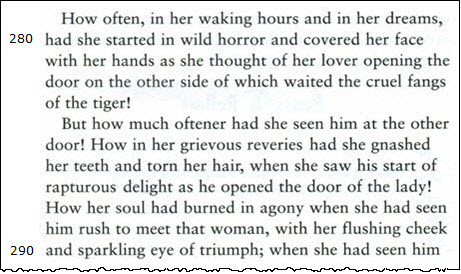
5⠀⠀⠀,h[ (t51 9 h] wak+ h\rs & 9 h] #bgi
6⠀dr1ms1⠀⠀⠀_h %e />t$ 9 wild horror #bhj
7⠀& cov]$ h] face⠀⠀⠀) h] h&s z %e #bha
8⠀?"\ ( h] lov] op5+ !⠀⠀⠀door on ! #bhb
9⠀o!r side ( : wait$ ! cruel fangs
10 ( ! tig]6 #bhc
11 ⠀⠀,b h[ m* (t5] _h %e se5 hm at ! #bhd
12 o!r⠀⠀⠀door6 ,h[ 9 h] griev\s #bhe
13 r"eies _h %e gna%$⠀⠀⠀h] tee? & #bhf
14 torn h] hair1 :5 %e saw 8 />t (
15 raptur\s deli<t z he op5$ ! door ( #bhg
16 ! lady6⠀⠀⠀,h[ h] s\l _h burn$ 9 #bhh
17 agony :5 %e _h se5⠀⠀⠀hm ru% to #bhi
18 meet t woman1 ) h] flu%+ *eek⠀⠀⠀& #bij
19 sp>kl+ eye ( triumph2 :5 %e _h se5
20 hm

1⠀⠀⠀⠀⠀⠀⠀@.<,?ree blank cells o3urr+ #,-
2⠀⠀⠀⠀⠀)9 a brl l9e 9dicate ! 2g9n+ ( a new
3⠀⠀⠀⠀⠀pr9t l9e4@.>
4⠀⠀⠀⠀⠀⠀⠀⠀⠀⠀⠀⠀⠀⠀⠀⠀⠀⠀⠀⠀⠀⠀⠀⠀⠀⠀⠀⠀⠀⠀⠀⠀⠀⠀⠀⠀⠀⠀⠀⠀⠀
5⠀,x ra9$ all afn 9 a s+le t"o4 ,9 ! #a
6⠀uni=m & p1ce;l⠀⠀⠀9t5s;y y cd he> ! #b
7⠀wat] fall1 ! way x is :5 y travel
8⠀all⠀⠀⠀afn on a tra94 ,b )\t \r #c
9⠀notic+ x1 ! ra9 0 p5e-⠀⠀⠀trat+ too #d
10 deeply 9to \r s5ses4 ,e>ly ,mon"d
11 morn+1 :5 we⠀⠀⠀clos$ ! door to avoid #e
12 ! cutt+1 icy draft t blew 9 f !
13 c\rty>d1 \r s5ses _h be5 fill$ ) #f
14 ra94 ,& on ,mon"d
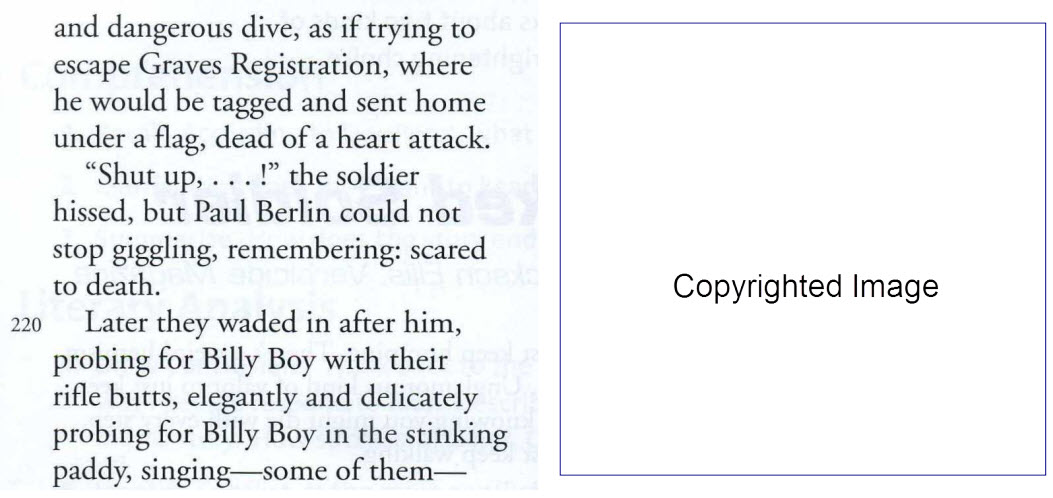
1⠀⠀⠀⠀⠀⠀⠀⠀⠀⠀⠀⠀⠀⠀⠀⠀⠀⠀⠀⠀⠀⠀⠀⠀⠀⠀⠀⠀⠀⠀⠀⠀⠀⠀⠀⠀⠀ #,-
2⠀& dang]\s dive1 z if try+ to #bab
3⠀escape ,graves ,regi/ra;n1 ": #bac
4⠀he wd 2 ta7$ & s5t home #bad
5⠀"u a flag1 d1d ( a he>t attack4 #bae
6⠀⠀⠀8,%ut up1 44460 ! soldi] #baf
7⠀hiss$1 b ,paul ,b]l9 cd n #bag
8⠀/op gi7l+1 rememb]+3 sc>$ #bah
9⠀to d1?4 #bai
10 ⠀⠀,lat] !y wad$ 9 af hm1 #bbj
11 prob+ = ,billy ,boy ) _! #bba
12 rifle butts1 elegantly & #bbb
13 delicately⠀⠀⠀prob+ = ,billy ,boy 9 #bbc
14 ! /9k+⠀⠀⠀paddy1 s++,-"s ( !m,- #bbd
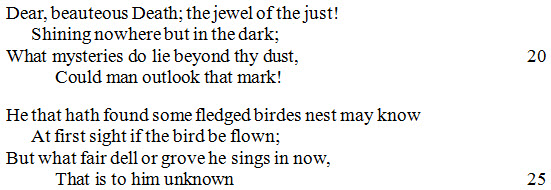
1⠀⠀⠀⠀⠀⠀⠀⠀⠀⠀⠀⠀⠀⠀⠀⠀⠀⠀⠀⠀⠀⠀⠀⠀⠀⠀⠀⠀⠀⠀⠀⠀⠀⠀⠀⠀⠀⠀#,-
2⠀,de>1 b1ute\s ,d1?2 ! jewel ( ! j6
3⠀⠀⠀,%9+ no": b 9 ! d>k2
4⠀,:at my/]ies d lie 2y ?y du/1 #bj
5⠀⠀⠀⠀⠀,cd man \tlook t m>k6
6⠀⠀⠀⠀⠀⠀⠀⠀⠀⠀⠀⠀⠀⠀⠀⠀⠀⠀⠀⠀⠀⠀⠀⠀⠀⠀⠀⠀⠀⠀⠀⠀⠀⠀⠀⠀⠀⠀⠀⠀⠀
7⠀,he t ha? f.d "s fl$g$ birdes ne/
8⠀⠀⠀⠀⠀⠀⠀may "k
9⠀⠀⠀,at f/ si<t if ! bird 2 fl[n2
10 ,b :at fair dell or grove he s+s 9
11 ⠀⠀⠀⠀⠀⠀n[1
12 ⠀⠀⠀⠀,t is to hm un"kn #be
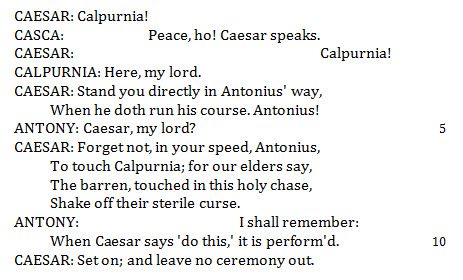
3⠀,,caes>3 ,calpurnia6
4⠀,,casca3⠀⠀⠀,p1ce1 ho6 ,caes> sp1ks4
5⠀,,caes>3⠀⠀⠀,calpurnia6
6⠀,,calpurnia3 ,"h1 my "l4
7⠀,,caes>3 ,/& y directly 9
8⠀⠀⠀⠀⠀,antonius' way1
9⠀⠀⠀,:5 he do? run 8 c\rse4
10 ⠀⠀⠀⠀,antonius6
11 ,,antony3 ,caes>1 my "l8 #e
12 ,,caes>3 ,=get n1 9 yr spe$1
13 ⠀⠀⠀⠀,antonius1
14 ⠀⠀,to t\* ,calpurnia2 = \r eld]s
15 ⠀⠀⠀⠀say1
16 ⠀⠀,! b>r51 t\*$ 9 ? holy *ase1
17 ⠀⠀,%ake (f _! /]ile curse4
18 ,,antony3⠀⠀⠀,i % rememb]3
19 ⠀⠀,:5 ,caes> says ,8d ?1,0 x is #aj
20 ⠀⠀⠀⠀p]=m'd4
21 ,,caes>3 ,set on2 & l1ve no c]emony
22 ⠀⠀⠀⠀\4
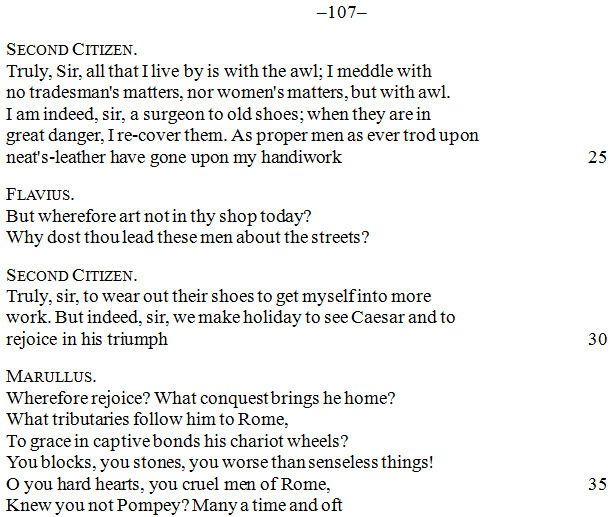
1⠀⠀⠀⠀⠀⠀⠀⠀⠀⠀⠀⠀⠀⠀⠀⠀⠀⠀⠀⠀⠀⠀⠀⠀⠀⠀⠀⠀⠀⠀⠀⠀⠀⠀⠀⠀⠀#ajg
2⠀,second ,citiz54 ,truly1 ,sir1 all #ba
3⠀⠀⠀t ,i live by is ) ! awl2 ,i m$dle
4⠀⠀⠀)⠀⠀⠀no tradesman's matt]s1 nor #bb
5⠀⠀⠀wom5's matt]s1 b ) awl4⠀⠀⠀,i am #bc
6⠀⠀⠀9de$1 sir1 a surgeon to old %oes2
7⠀⠀⠀:5 !y >e 9⠀⠀⠀grt dang]1 ,i #bd
8⠀⠀⠀re-cov] !m4 ,z prop] m5 z "e trod
9⠀⠀⠀^u⠀⠀⠀n1t's-l1!r h g"o ^u my #be
10 ⠀⠀h&i"w
11 ,flavius4 ,b ":=e >t n 9 ?y %op td8
12 ⠀⠀,:y do/ ?\ l1d ^! m5 ab ! /reets8
13 ,second ,citiz54 ,truly1 sir1 to #bh
14 ⠀⠀we> \ _! %oes to get myf 9to m
15 ⠀⠀"w4 ,b 9de$1 sir1 we make holi"d #bi
16 ⠀⠀to see ,caes> & to⠀⠀⠀rjc 9 8 #cj
17 ⠀⠀triumph
18 ,m>ullus4 ,":=e rjc8 ,:at 3que/
19 ⠀⠀⠀⠀br+s he home8
20 ⠀⠀,:at tribut>ies foll[ hm to
21 ⠀⠀⠀⠀,rome1
22 ⠀⠀,to grace 9 captive bonds 8 *>iot
23 ⠀⠀⠀⠀:eels8
24 ⠀⠀,y blocks1 y /"os1 y worse ?an
25 ⠀⠀⠀⠀s5se.s ?+s6
—New Braille Page—
1⠀⠀⠀⠀⠀⠀⠀⠀⠀⠀⠀⠀⠀⠀⠀⠀⠀⠀⠀⠀⠀⠀⠀⠀⠀⠀⠀⠀⠀⠀⠀⠀⠀⠀⠀⠀a#ajg2⠀⠀⠀,o y h>d he>ts1 y cruel m5 ( #ce
3⠀⠀⠀⠀⠀,rome1
4⠀⠀⠀,knew y n ,pompey8 ,_m a "t & (t #cf
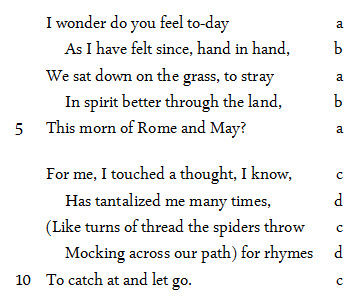
5⠀⠀⠀⠀⠀⠀⠀@.<,! poem has l9e numb]s & a
6⠀⠀⠀⠀⠀rhyme s*eme4 ,! l9e numb]s >e e fif?
7⠀⠀⠀⠀⠀l9e & at ! "r m>g94 ,! lr$ rhyme
8⠀⠀⠀⠀⠀s*eme is on e l9e & appe>s 2f ! l9e
9⠀⠀⠀⠀⠀numb]s4@.>
10 ⠀⠀⠀⠀⠀⠀⠀⠀⠀⠀⠀⠀⠀⠀⠀⠀⠀⠀⠀⠀⠀⠀⠀⠀⠀⠀⠀⠀⠀⠀⠀⠀⠀⠀⠀⠀⠀⠀⠀⠀
11 ,i wond] d y feel to-"d a
12 ⠀⠀,z ,i h felt s9ce1 h& 9 h&1 ;b
13 ,we sat d[n on ! grass1 to /ray a
14 ⠀⠀,9 _s bett] "? ! l&1 ;b
15 ,? morn ( ,rome & ,may8 a⠀⠀#e
16 ⠀⠀⠀⠀⠀⠀⠀⠀⠀⠀⠀⠀⠀⠀⠀⠀⠀⠀⠀⠀⠀⠀⠀⠀⠀⠀⠀⠀⠀⠀⠀⠀⠀⠀⠀⠀⠀⠀⠀⠀
17 ,= me1 ,i t\*$ a ?"\1 ,i "k1 ;c
18 ⠀⠀,has tantaliz$ me _m "ts1 ;d
19 "<,l turns ( ?r1d ! spid]s ?r[ ;c
20 ⠀⠀,mock+ acr \r pa?"> = rhymes ;d
21 ,to cat* at & let g4 ;c⠀#aj
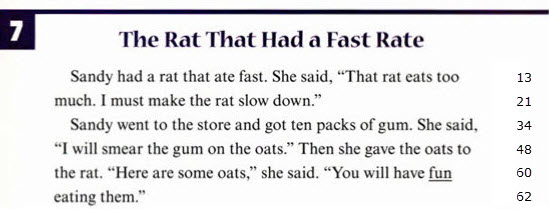
5⠀⠀⠀⠀⠀⠀⠀@.<,?ree blank cells 9dicate ! 5d
6⠀⠀⠀⠀⠀( a pr9t l9e4 ,! numb]s 9 ! "r m>g9
7⠀⠀⠀⠀⠀>e ! numb] ( ^ws r1d at ! po9t ( !
8⠀⠀⠀⠀⠀?ree blank cells4@.>
9⠀⠀⠀⠀⠀⠀⠀⠀⠀⠀⠀⠀⠀⠀⠀⠀⠀⠀⠀⠀⠀⠀⠀⠀⠀⠀⠀⠀⠀⠀⠀⠀⠀⠀⠀⠀⠀⠀⠀⠀⠀
10 ⠀⠀⠀⠀⠀⠀,! ,rat ,t ,_h a ,fa/ ,rate
11 ⠀⠀⠀⠀⠀⠀⠀⠀⠀⠀⠀⠀⠀⠀⠀⠀⠀⠀⠀⠀⠀⠀⠀⠀⠀⠀⠀⠀⠀⠀⠀⠀⠀⠀⠀⠀⠀⠀⠀⠀
12 ⠀⠀,s&y _h a rat t ate fa/4 ,%e sd1
13 8,t rat eats too⠀⠀⠀m*4 ,i m/ make ! #ac
14 rat sl[ d[n40 #ba
15 ⠀⠀,s&y w5t to ! /ore & got t5 packs
16 ( gum4 ,%e sd1⠀⠀⠀8,i w sme> ! gum #cd
17 on ! oats40 ,!n %e gave ! oats to #dh
18 ! rat4 8,"h >e "s oats10 %e sd4 8,y
19 w h _1fun #fj
20 eat+ !m40 #fb

1⠀⠀⠀⠀⠀⠀⠀⠀⠀⠀⠀⠀⠀⠀⠀⠀⠀⠀⠀⠀⠀⠀⠀⠀⠀⠀⠀⠀⠀⠀⠀⠀⠀⠀⠀⠀⠀#add
2⠀⠀⠀,?us did ,we %[ ,abraham ! k+dom #gf
3⠀( ! h1v5s & ! e>? t he mi<t 2 ( ^?
4⠀possess+ c]ta9ty3
5⠀⠀⠀,:5 ! ni<t grew d>k ^u hm he #gg
6⠀2held a />4 ,he sd3 ,? is my ,"l4
7⠀,b :5 x set1 he sd3 ,i love n ?+s t
8⠀set4